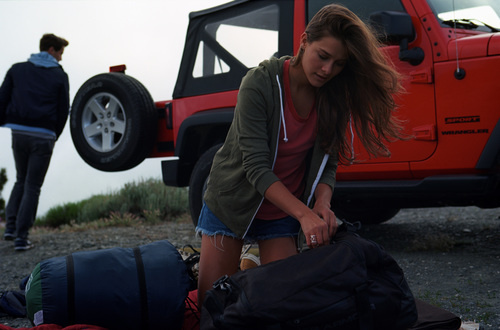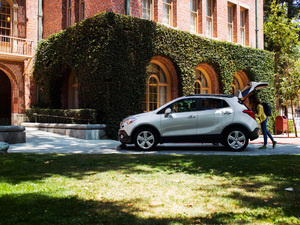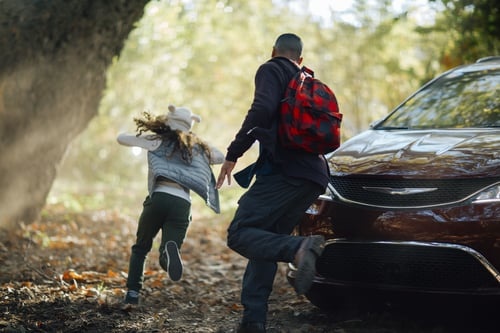I started my journey in photography back in 2011. Since then, there are only a handful of photographers that I have really paid attention to in terms of actively keeping up with their work. One of those photographers is Commercial Photographer Dave Hill. His work has taken a more drastic turn in just a few years than any photographer that I’ve followed. That’s one of many reasons that I reached out to Hill to chat about his work and photography.
Let’s start with where I first saw Hill's work. In the fall of 2015, Fstoppers published this article showcasing some of his compositing talent. The final images are incredible: a huge set, tons of extras, a Hasselblad, and a sizeable crew. I was enamored by the effort going into these incredibly complex photos. From that point, I found all sorts of video content showing Hill's workflow and his on-set experiences. It’s rare to get such a glimpse into the world of commercial photography, so naturally I tried to watch about everything out there. Over time, however, I started to notice that Hill's work became less and less complex in a certain sense. Did it diminish in quality? Not in the slightest, but his lighting, and post-processing seemed to become a smaller part of the finished work. Film even began making an appearance in his work, showing a real turn from the previously Photoshop-heavy workflow made possible by digital systems.
Hill’s start in photography came about in his early years. He remembers having a camera as early as fourth grade and an enlarger with which to experiment in printing. From there, his interest followed him into other hobbies. Photography became a more prominent part of his life through high school as he began to shoot more and more. In a sense, his first job as a photographer came about at the student paper he shot for during his time at UCLA. He recalls shooting all black and white film back then on various assignments and the process of scanning the negatives to be used in digital print processes. By his senior year at the school, he was the photo editor. Straight out of school, Hill worked as a photographer for Loyola Marymount University in Los Angeles. He shot everything from sports, to student life, to various advertising related assignments for the school.
His life took somewhat of a turn when he moved to Nashville, Tenn. at the young age of 23, quite the departure from the west coast lifestyle he was accustomed to. In a sense, his career started over. In Nashville, his work was all freelance. Rather than a stable photography gig like that at an accredited university where something is always happening, Hill now had to market himself and his work to specific clients. Nashville being Nashville, a music mecca, his work focused primarily on musicians of various genres at the time. This is where his signature composite style came from. Giving Hill an edge over many other music photographers, the style helped him to pick up some steam. On top of that, automotive photography began to tie in as well. With more and more cars showing up in the music work that he was creating, his bold look attracted the attention of various folks in the car industry. He recalled that once his agent started to pitch his work to brands like Fiat, it snowballed.
While Hill's work has encompassed many household car brands, that work has also encompassed a massive shift in style. As he told me, over time the process of heavy compositing became somewhat tiresome. From my limited experience in that genre, the amount of work that would go into such a large scale shoot with that style would be tremendous as every setup suddenly requires not just more setup time, but more time in post-processing to make it come to life. Slowly he found himself going back to film as a medium in his work; shooting it along side digital on many jobs. And with film, came a more simplistic approach to photography. Even in his newer digital work, the effect shows itself. Hill’s images have become cleaner in their lighting and design, yet more bold.
https://vimeo.com/album/98351/video/135503202
This transition worked for him, as he stayed ahead of the aesthetic curve in the advertising world. While the heavy composite look that digital made possible was popular for a time because of it’s strikingly unnatural look, the wave died down. Hill recalled that he slowly began to send out more promos for his more natural looking work and eventually stopped marketing his compositing work and art directors and agents loved it. As the composite era died, something else had to take its place and Hill was in position.



It wasn’t exactly the film that did it for him (though I highly recommend looking at this article we posted about his Jeep shoot that was all done on film). Hill told me that he often had trouble incorporating film into some larger shoots due to the headache it can cause in postproduction. With the Honda campaign, he asked them if they minded him shooting some film alongside digital and they gave him the green light. Hill told me that while a few made his cut, the client chose almost all digital for their uses. That didn’t stop him from shooting film in the future for a Buick campaign, however.








https://vimeo.com/album/98351/video/136115855
Hill did say that while film hasn’t been the greatest option for automotive work (he’ll likely stick with digital for that), he said that any lifestyle or people related work he shoots will have film incorporated. After seeing one of his latest works, "Don’t Hate Kate," I can understand why. This series, created by Hill from start to finish, is incredibly refreshing. In 51 photos, we see a conflict unfold in a violent fashion. The idea started for him as a way to test a sort of long form storytelling. He envisioned being able to apply a similar idea with various ad campaigns that would integrate better into today’s world of social media. "Don’t Hate Kate" was created around the location it was shot at, a property owned by a friend. Shooting the project took a few days at the location in order to get all of the necessary shoots, not unlike a very short film shoot as the talent performed the motions of each scene as Hill shot around them. The entire project was shot on Kodak Gold 200, one of the cheapest film stocks available. Having used the film myself and never really loving it, I asked him why that specifically. Hill told me that of all the print films available, it had just the right color and grain for what he wanted. Portra being a rather desaturated film, it wasn’t intense enough. On the other end of the spectrum is Ektar, an amazing film that unfortunately doesn’t do well with skin tones due to the extreme saturation. Gold 200 is what many refer to as a drug store film, so it adds a little grain you wouldn’t usually find in slower speed films, aiding the gritty feeling in the series.
https://vimeo.com/album/98351/video/185826243
After finishing shooting and selecting the final images he printed 1,000 copies of the book and mailed them out to various agencies and brands. If anything, Hill has been able to start new conversations with various brands. While he admitted that the idea was somewhat grotesque, it’s a wonderful example of storytelling that is not often seen in still photography.




Naturally with the creative and technical ability to create a series like "Don’t Hate Kate," Hill is also a filmmaker. Hill expressed that his interest in filmmaking goes back as far as the early 2000s, having written several short films over the years, many of which can be view on his Vimeo page. We talked a little about his most recent piece, "Flying Cars," a film about a new found hobby of RC car racing and how it changes a man's life. From a production standpoint it’s a small film but Hill funded it himself. Hill wrote and directed the film which has yet to get a release date, though a teaser trailer can be viewed on his Vimeo page.
I asked him about what sort of challenges he faced as a filmmaker and how it can differ from still photography. Hill said of the "Flying Cars" project that scheduling becomes much more difficult. Since there are so many moving parts to a film production, even on the small scale, it’s imperative to have the proper crew. Throughout the shooting of "Flying Cars," Hill said that he would often have different assistants during the few weeks of filming due to various scheduling conflicts and no shows that can happen on self funded indie films. The film was shot in it’s entirety, however, and is now being edited. Outside of indie film work, Hill has also been able to provide his talents to some of his automotive clients.
To end our conversation, I asked him what sort of advice he might offer for those looking to follow a similar path of freelancing. Hill made it clear that doing the leg work is critical. During his time in Nashville, he would often travel to L.A. and New York to get his portfolio out in front of potential clients and agents. Eventually, it paid off and he started to work with a rep in L.A. that gave him a few gigs to see how things panned out. Eventually it led to a gig for Interscope Records. Someone there introduced him to his current rep and the rest is history.
Hard work goes a long way in or industry, and that’s been made quite clear by Hill and his fantastic portfolio. From his work on a college newspaper to being one of the most talented car and lifestyles photographers around, it’s been an interesting journey for him. Don’t be afraid to experiment with your work, always be searching for new opportunities, and put your work out there. Otherwise, it will never be recognized. I highly recommend you check out Dave Hill's work on his website and follow him on Instagram.







Dave Hill, by far one of my favorites! The best part about that jeep series was rig shots by film, he was so casual about something not going how it was supposed to, he stayed composed and just kept on going! true pro!